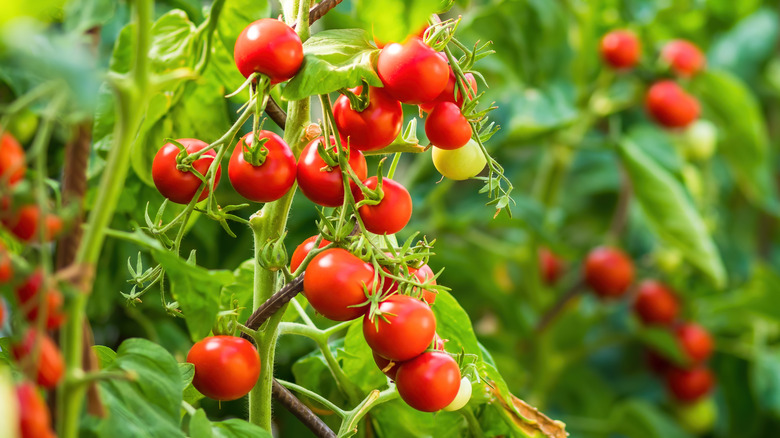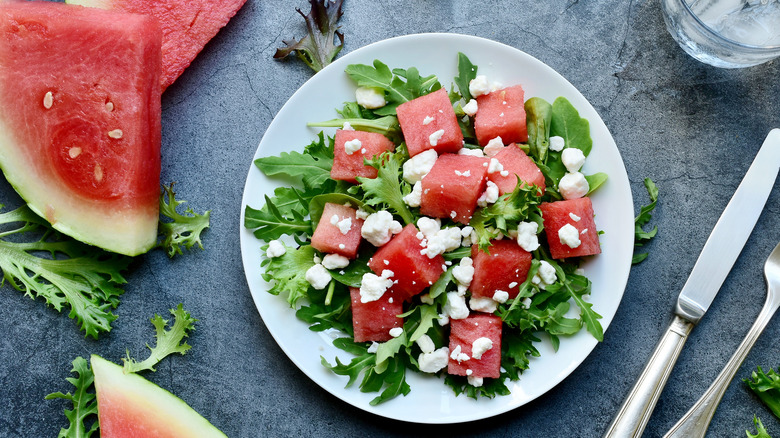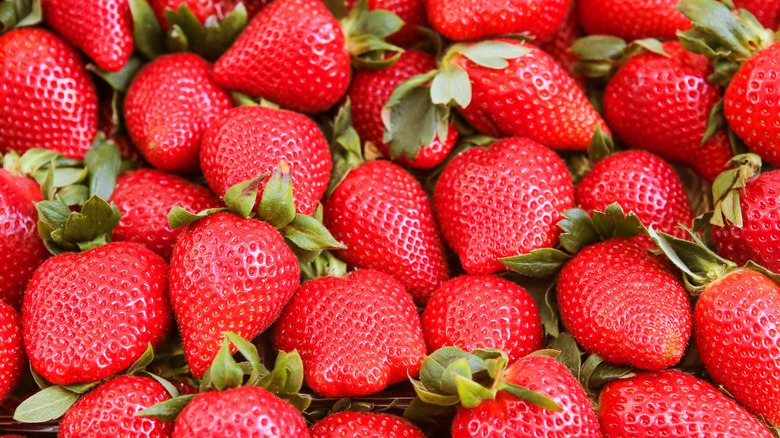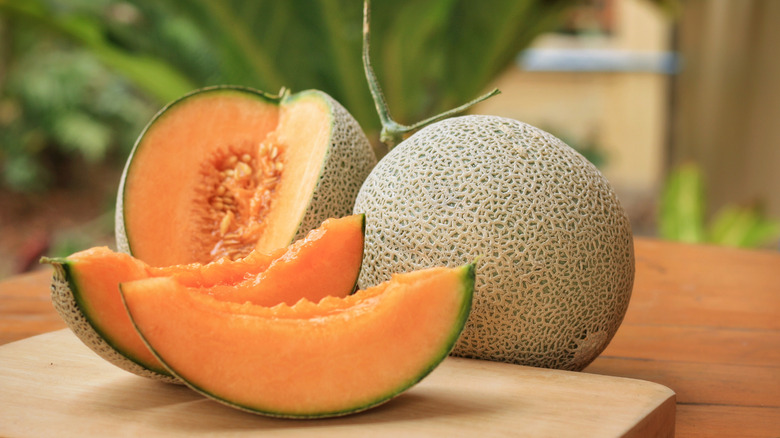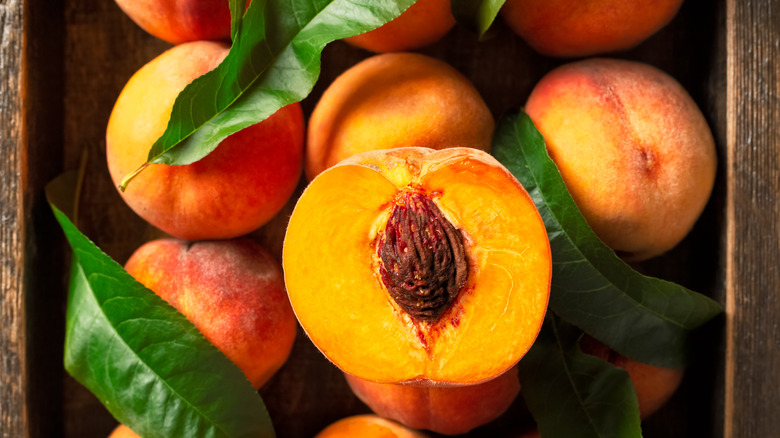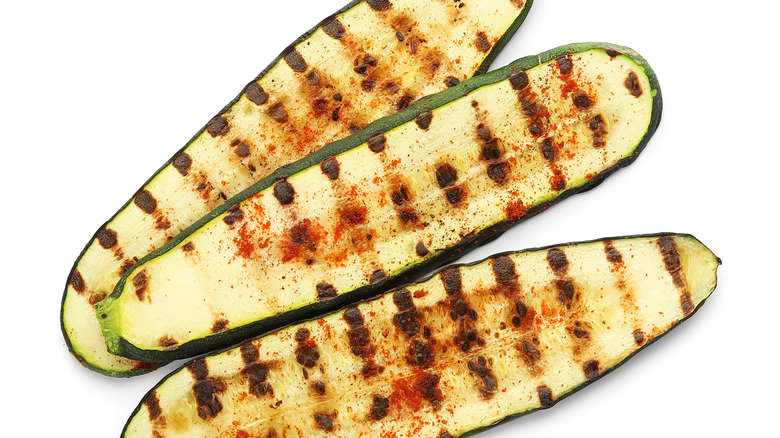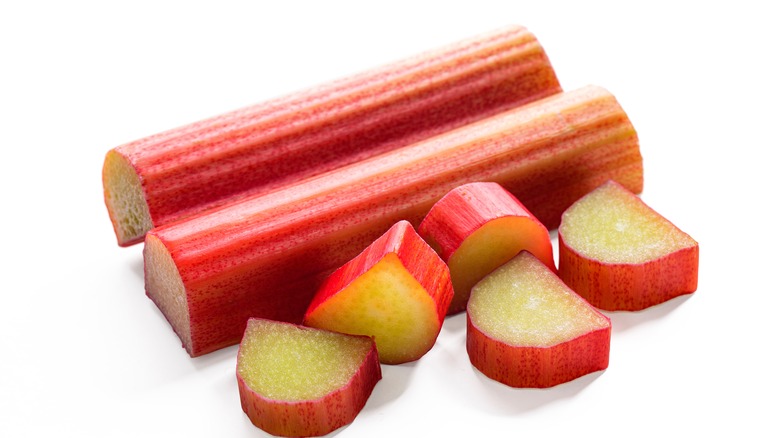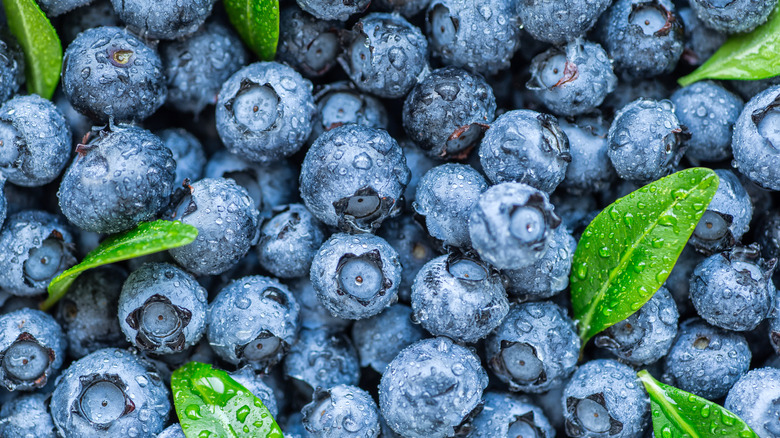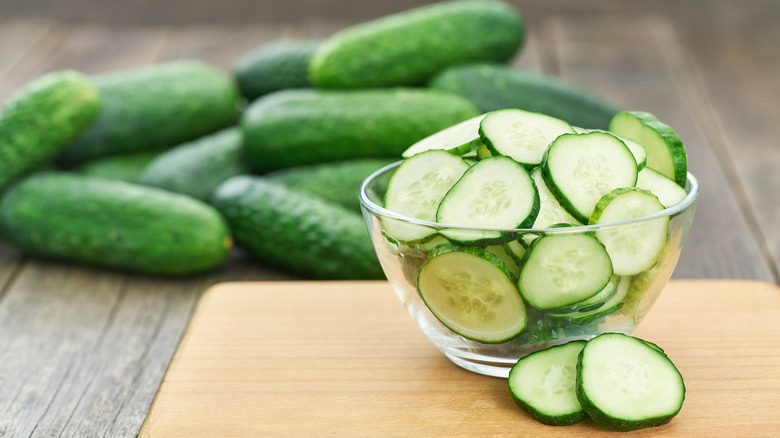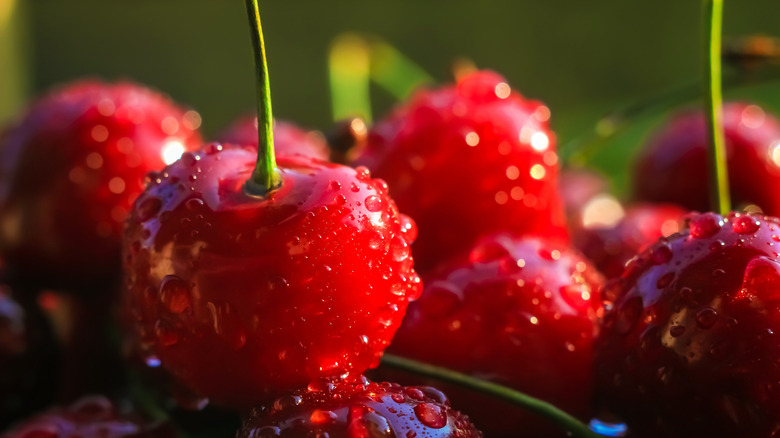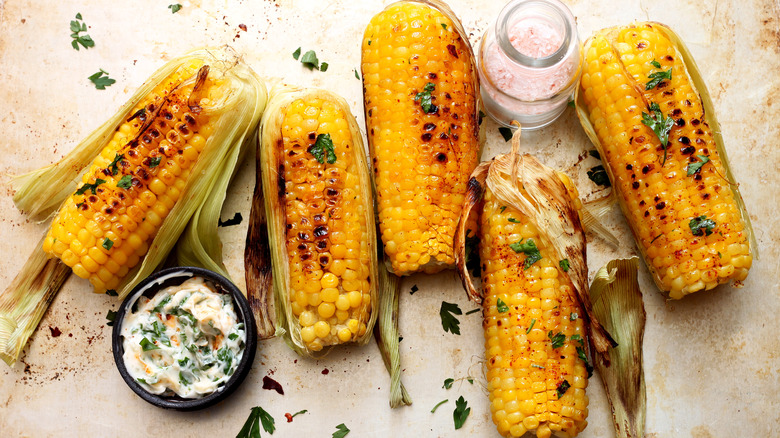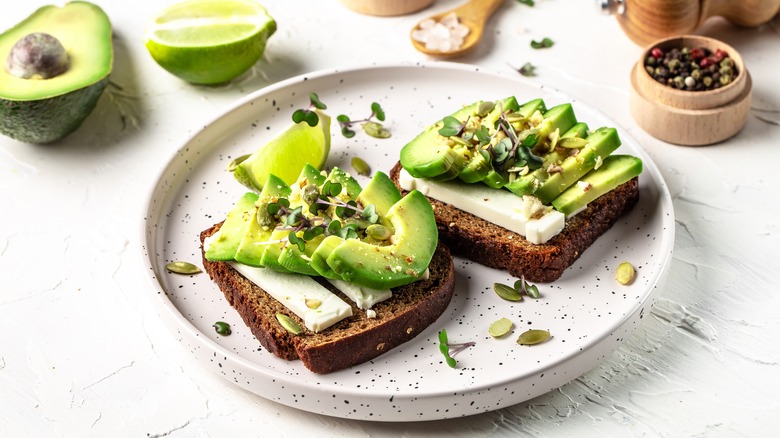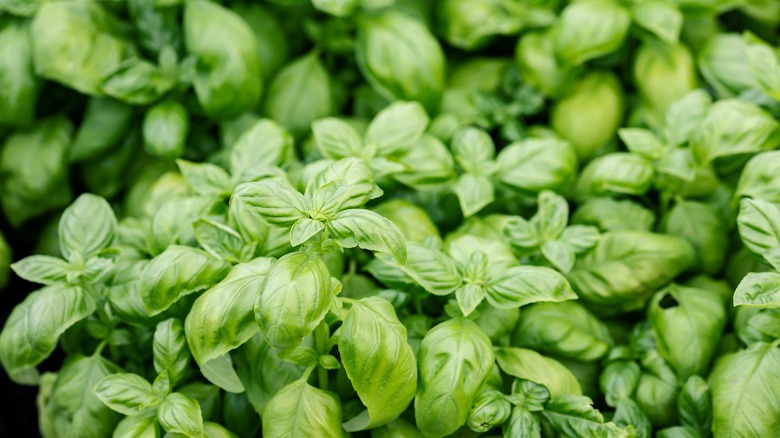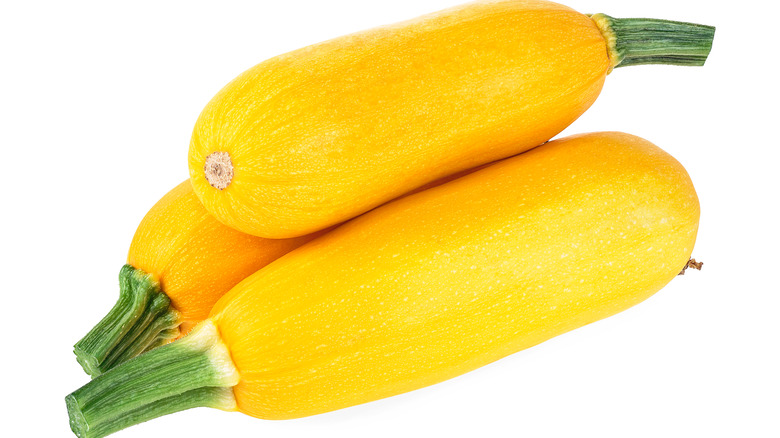The Best Summer Foods For Your Health
Summer is many people's favorite time of year. The warm weather that invites you outside to get in all that exercise that somehow fell off your to-do list in winter and spring, the many outdoor events, and of course — the food — all make it a special season. While eating fruits and vegetables is a must year-round, certain produce that is in season during the summer is that much more delicious because of how fresh it is. Whether you fire up the grill, arrange an abundant fruit or veggie platter, or whip up a colorful salad, there are many ways to enjoy the seasonal produce of summer.
According to the USDA's Seasonal Produce Guide, while seasonal fruits and vegetables may vary according to the growing conditions and weather in your area, there are some generalized standards that apply across the board. Some summer fruits and veggies you can expect to find include summer squash, watermelon, celery, eggplant, and lemon, just to name a few. Working fruits and vegetables into your summer diet can be both easy and good for your health. If you're looking for inspiration on what fruits and veggies to add to your regimen this summer, and to learn what benefits they offer, continue reading.
Tomatoes
This red, round, juicy fruit — yes, you read that right, fruit — is a summer favorite for many reasons. While many people may use tomatoes as a "culinary vegetable" (in that it's often served along other veggies or used for other savory purposes, per Healthline), this delicious summer staple is actually a fruit from the nightshade family of plants, according to Healthline. They have a range of health benefits, but one of the things tomatoes are perhaps most known for is their high levels of the antioxidant lycopene. Experts at Healthline explain that lycopene, a red pigment, has been known to reduce the levels of both heart disease and cancer. The lycopene in tomatoes can also help protect your skin from the sun's UV rays. In a study published in the Journal of Nutrition, researchers exposed subjects to a solar simulator on a small patch of skin and separated them into two groups — some consumed tomato paste, and the others were given olive oil. The study found that those who consumed the paste had 40% fewer sunburns when compared to the other group. This helpful antioxidant is found in the skin of the tomato, and is actually present in higher concentrations in processed products such as ketchup, tomato paste, and sauce.
Furthermore, tomatoes are a solid source of fiber, offering 1.5 grams per serving. They are also a high source of vitamin C, with one mid-sized tomato able to provide around 28% of the daily recommended intake.
Watermelon
Watermelon is one of those classic staples that upon mere mention takes you straight to the summer months. Whether plated up for breakfast, lunch, or dinner, watermelon is a sweet and delicious snack that serves a number of health benefits. Watermelon belongs to the cucurbitaceae family of fruits, which also includes cucumber, cantaloupe, and even squash, according to Medical News Today. One of watermelon's key benefits is its high water content: The fruit is approximately 90% water, so consuming it is an excellent way to stay hydrated during the hot days of summer. And another bonus? A watermelon's electrolyte content can help keep all your body's functions ticking along.
Watermelons also contain cancer- and heart disease-fighting antioxidants. Additionally, some antioxidants in watermelon — including L-citrulline and L-arginine – have been found to lower blood pressure. For instance, one study published by the American Journal of Hypertension found that middle-aged people who consumed watermelon extract regularly saw a reduction in their blood pressure.
Strawberries
Red, succulent, and full of nutrients, strawberries are a versatile fruit that can be found in abundance in the summer months. Although small in size, strawberries pack a lot of nutritional benefits, according to WebMD, including but not limited to improving heart health, lowering your cholesterol, and helping to prevent cancer. Experts at the site explain that strawberries are actually a member of the rose family of plants. And believe it or not, a strawberry is actually not a fruit or a berry — it is the "enlarged receptacle of the flower."
Healthline explains that strawberries are about 90% water, making them an especially hydrating food. They are low in fat and carbs, which also makes them a good addition to any weight loss plan. While they contain 4.9 grams of sugar per serving, Healthline explains that they are low on the glycemic index, meaning they do not contribute to spikes in blood sugar and can be incorporated into the diets of diabetics. They do contain 7.7 grams of carbs, which is relatively low, according to the site — and 26% of their carb content is comprised of fiber, which can aid in digestion and gut health.
Cantaloupe
A member of the cucurbitaceae family of plants, cantaloupe is another classic summer fruit that deserves a spot on this list. There are many reasons to love cantaloupe, and MedicineNet outlines a long list of its benefits, starting with improved vision. The high concentration of Vitamin C, zeaxanthin, and carotenoids in the fruit all contribute to lowering the risk of cataracts, as well as macular degeneration, a disease that can cause loss of vision. And although cantaloupe does contain sugar, it is low on the glycemic index, meaning its sugar is digested more slowly, making it good dietary choice for those with diabetes. Potassium, which experts say can help reduce your blood pressure, is another star ingredient in cantaloupes.
If you're looking for an immune boost, cantaloupe can help with that as well. It's high levels of phytonutrients as well as vitamin A can help improve your immune system and fight of disease. Furthermore, for women who are pregnant or who want to be, cantaloupe is a significant source of folate, which is a key nutrient in fetal development to help prevent neural tube defects (such as spina bifida), as well as increase the red blood count of both the mother and baby.
Peaches
In many ways peaches are emblematic of summer. Peach cobbler, fizzy peach cocktails, and grilled peaches top the list of delicious treats you can prepare with this summer fruit. Aside from just being plain delicious, peaches also come bearing a number of nutritional benefits. Healthline explains that peaches, which are a member of the stone fruit family of fruits along with apricots, plums, and cherries, have roots that extend back to ancient China. They provide 17% of the daily value of vitamin C, 10% of the daily recommended value of vitamin A, and 8% of the daily recommended value of potassium. Furthermore, they contain high levels of antioxidants, which are known to protect against cancer. While canned peaches do bear some of the same benefits as fresh one, experts explain that fresher and riper peaches contain the most antioxidants.
If you need help in the digestion department, one medium peach contains two grams of fiber — both soluble and insoluble. Experts at Healthline explain that soluble fiber is the kind that adds beneficial bacteria to your gut, and that insoluble fiber is the kind that "bulks your stool," making it easier for it to pass. To get the most nutritional benefits out of peaches, Healthline suggests eating them raw, baked, on salads, or in salsa.
Zucchini
Zucchini is yet another star in the cucurbitaceae family of plants that made its way onto the summer list (via Healthline). Like watermelon, it is botanically considered a fruit although it's mostly incorporated into savory dishes alongside other vegetables. Zucchinis have high levels of many nutrients, including 40% of the daily recommended value of vitamin A, 16% of the daily recommended value of manganese, 13% of the daily recommended value of potassium, and a wealth of others. Some of its nutrient value will depend on how you prepare and consume your zucchini: Healthline reports that raw zucchini offers less vitamin A than cooked zucchini, but on the other hand, raw zucchini offers higher levels of vitamin C than cooked zucchini.
Like almost every other item on this list, zucchinis are high in antioxidants, specifically lutein, zeaxanthin, and beta-carotene, which are also known to be beneficial for the eyes, skin, and heart. For those with type 2 diabetes, zucchini can also contribute to lowering blood sugar. Because it is low in carbohydrates, it represents a good alternative to carb-heavy pasta dishes that are known to spike blood sugar levels, and can even be "spiralized" to mimic the look of spaghetti.
Rhubarb
Rhubarb is a summer food that may not get as much attention as some others on the list, but is nevertheless packed with benefits. Though according to WebMD it is technically a vegetable, you are likely to find rhubarb hiding out in sweeter fare such as cobblers, tarts, and other desserts. Despite this fact, rhubarb can be incorporated into a healthy summer diet. WebMD shares that rhubarb contains high levels of vitamin K, which is particularly good for preventing blood clots and helping with bone formation, and might help keep calcification from forming in your blood vessels. Rhubarb also contains noteworthy levels of vitamin A, which is known to help improve the health of skin and hair. If you're wondering just how to select and prepare this summer vegetable, WebMD suggests first making sure to select a stalk that is "firm and crisp" and has smaller leaves, meaning that it is younger. Additionally, avoid cutting the stalks until you are ready to eat them. To prepare rhubarb in a healthy way, you can add it to juices or kombucha, blend it into a sauce, or roast it and add it to a salad.
Blueberries
Blueberries have earned the label superfood for a reason: Among other things, they help guard against heart disease, cancer, bone disease, and even brain health, according to Medical News Today. One of the major nutritional components of blueberries is a compound called anthocyanin, which gives the fruit its characteristic blue color. Anthocyanin is a flavonoid, which experts at the site explain is a specific type of plant compound that acts as an antioxidant. Healthline notes that anthocyanins have actually been incorporated into medicine for hundreds of years, and have been linked to the reducing the risk of type-2 diabetes and cancer, and improving brain function.
Blueberries have also been linked to improved bone health due to their high levels of "iron, phosphorus, calcium, magnesium, manganese, zinc, and vitamin K," according to Medical News Today. Furthermore, blueberries contain high levels of vitamin C (24% of the daily recommended value in one cup, to be exact), which has been linked to increases in collagen production, which can improve the appearance of skin. A perhaps lesser-known effect of blueberries is the positive impact they can have on the brain. Medical News Today notes that eating blueberries has been shown by research to inhibit cognitive decline in older women, and has also been shown to improve short-term memory.
Cucumber
Cucumber: refreshing, light, delicious, and full of nutrients. Another member of the cucurbitaceae family of plants, cucumber is yep, you guessed it — a fruit. Healthline reports that this delicious cucurbit is shockingly low in calories, clocking in a mere 45 calories per 300 gram serving. Combine the low calorie count with zero grams of fat, and you have every dieter's dream food. Regarding nutrients, cucumbers provide 62% of the daily recommended value of vitamin K, 13% of the daily recommended value of potassium, and 12% of the daily recommended value of manganese. Furthermore, cucumbers are comprised of 96% water, which makes them another great food to help you stay hydrated in hot temperatures.
In order to get the most of the nutrients, Healthline experts recommend eating them with the peel intact, as that is where most of the fiber, vitamins, and minerals are found. For those who want to lose weight, Healthline explains that adding cucumbers to your diet is a great way to do it. Studies have shown that consuming foods that are high in water and low in calories can contribute to decreases in weight. Additionally, cucumbers are an excellent source of soluble fiber, which can help you stay full for longer, according to another report from Healthline.
Cherries
Like peaches, cherries are another member of the stone fruit family that are consumed abundantly during the summer months. Sweet, delicious, and tempting, it's easy to grab handful after handful of this tiny fruit without thinking twice. The good news is the experts say that's perfectly fine to do — and in fact, they even encourage it. According to the experts at Health, cherries are one of the healthiest fruits out there, being chock full of antioxidants, vitamin C, and other vitamins and minerals. Additionally, if you are struggling with sleep, perhaps having a few cherries before bed can help you drift off more easily — as it turns out, tart cherries are one of the few sources of food that provide melatonin, the hormone responsible for managing our sleep cycle. And remember that while cherries may be in season during the summer, they can also be consumed frozen, powdered, or in juice form year-round.
Corn
Throwing a fresh ear of corn on the grill may as well be the official sign that summer has arrived. Corn is another versatile summer staple that can be eaten grilled, roasted, or boiled (via Kitchn). Mayo Clinic explains that corn is actually a grain, not a vegetable, and that its versatility has made it a worldwide favorite. One of the primary nutritional benefits of corn is that it is high in insoluble fiber, which is the type of fiber that adds bulk to stool and facilitates bowel movements. Furthermore, corn is a great source of B vitamins, as well as other minerals including zinc, magnesium, copper, iron and manganese.
One potential drawback of corn, however, is that it is a starch, and that half a cup of it dishes up 15 grams of carbohydrates. For those who want to manage their diabetes, if you're going to eat corn, make sure to count it as your carbohydrate choice for the meal. And if you're used to the classic yellow varieties of corn, experts at WebMD suggest trying other colored varieties such as blue or purple corn, which carry higher levels of antioxidants in the form of phytonutrients.
Avocado
Avocados are the cool kids on the block in the health food kingdom. They've edged their way into Instagram feeds galore, and are as healthy as they are delicious. While Healthline says that many people confuse avocados for being a fruit or a vegetable, the truth is they are actually a berry, and are native to Mexico and Central America. Experts at the site break down the nutritional benefits of the berry and explain that one 7-ounce avocado contains upwards of 322 calories with 30 grams of fat, 4 grams of protein, 4 grams of fiber, 28% of the daily recommended value of vitamin E, 22% of the daily recommended value of vitamin C, and a whole host of other micro and macro nutrients. While the calorie count and grams of fat may leave you aghast, don't be fooled. The fats found in avocados are in fact healthy fats that help your tummy feel fuller for longer, which can potentially lead to weight loss. Their high levels of fiber also help with satiety, and of course, with improving digestion as well. Furthermore, avocados are high in folate, offering 27% of the recommended daily intake, a huge plus for women who are pregnant.
Basil
Basil is a delicious and fragrant summer herb that can be found as a pizza topping, in salads, and incorporated into a number of savory dishes (via Love and Lemons). Healthline explains that basil is a member of the mint family, and that there are actually many varieties including sweet basil, Greek basil, and Thai basil to name a few. The herb has been used for centuries in Chinese medicine, Ayurvedic medicine, and other traditional practices to treat conditions from nausea to bug bites. Because basil is typically included in smaller quantities in dishes, the herb may not contribute major amounts of nutrients in a typical diet. However it does contribute significant amounts of vitamin K in both its fresh and dried form (it offers 13% of the daily recommended intake fresh or 43% of the daily recommended intake dried).
Despite the fact that it may not be a massive contributor of nutrients otherwise, basil does contain antioxidant properties due to its beneficial plant compounds. Furthermore, it is possible to get more out of your basil by consuming it in extract form. Early studies have found that sweet basil extract may help stave off memory loss due to stress and aging, reduce blood pressure, prevent certain cancers, and improve fasting blood sugar.
Yellow squash
Yellow squash is a summer favorite that can be incorporated into a variety of different dishes. Livestrong explains that yellow squash is included in the general category of "summer squash" and can come in shapes with both straight and crooked necks. Like its cucurbit cousin the cucumber, yellow squash is low in calories, offering as few as 20 per medium-sized squash. The carbs count in yellow squash is also low, making them a great option for those who may want to lose weight, as they can replace higher-calorie, higher-carb options like potatoes in certain dishes.
Yellow squash also contains considerable levels of vitamin C, as well as folate, iron (which can help increase red blood cell count and assist in preventing anemia), and antioxidants in the form of beta carotene, providing a high concentration of 135 micrograms per one-cup serving. And if you're concerned about your eye health, you can't go wrong by adding some yellow squash into your routine. This is because it contains lutein, which is known to prevent cataracts from developing, and has also been shown to prevent macular degeneration, which can lead to blindness.


